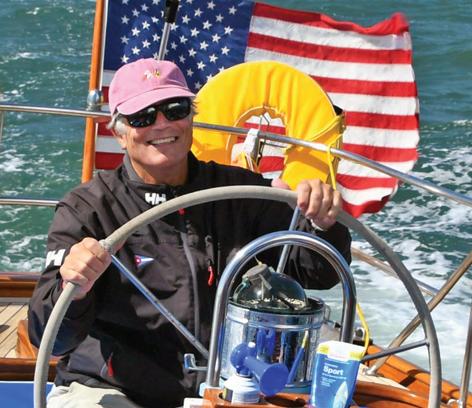
35 minute read
sightings
alpha — a labor of love putting the baja ha-ha
What do you say when someone invites you to sail San Francisco Bay on a beautifully maintained 48-ft classic sloop? "Yes." A few weeks ago we joined Nick Raggio for a spectacular sail on one of the Bay's gems, his S&S 48 Alpha, out of Sausalito's Schoonmaker Point Marina. It was a cool, breezy day and just right for the solidly built Alpha, Nick, and the crew of Roger Howard, Chris Lustic and Mario Schuhmann. Following the sail, we caught up with Nick to fi nd out more about both Alpha and Nick himself. Alpha is 47 feet, 6 inches long and was built at Stephens Marine in Stockton, California. Like many custodians of a classic, Nick has been gathering the history of Alpha in a scrapbook along with notes on Stephens Marine. Stephens operated from 1902 to 1987 and was famous for high-quality powerboats and sailboats, as well as for having a military contract for the Navy in WWII. With a price tag of $100,000, Alpha was the fi rst aluminum sailboat they built, in 1967. Nick fi gures he's the fi fth owner. The original owner was Theo Stephens of Stephens Marine. Nick says he was fortunate to fi nd Alpha through fellow club member and former St. Francis YC commodore Rick Pfaff. Pfaff owned her for 25 years and was a great custodian of the yacht. The boat
continued on outside column of next sightings page Registration will open at noon on May 6 for Ha-Ha XXVII, the world-famous 750mile cruiser's rally from San Diego to Cabo San Lucas. The earlier you sign up for the event, the higher up you will be on the list for the chance of getting a slip in Cabo. Ha-Ha XXVII will start on November 1 with a parade out of San Diego Bay. Local and Mexican offi cials, as well as a mariachi band, will be aboard the Dolphin to fi re the America's Cup cannon and launch the rally. Fireboats will be on hand for the traditional artifi cial rain send-off. Although it's not yet confi rmed, the Grand Poobah is confi dent there will be the traditional Ha-Ha Kickoff Halloween Costume Party at West Marine the day before, with representatives on hand from many marine-related businesses from Mexico.



ALL PHOTOS LATITUDE / JOHN
Spread: Regular crew, left to right, Roger Howard, Chris Lustic and Mario Schuhmann, with Nick Raggio at the helm. Top left: Nick Raggio. Bottom: Nick and Roger put her to bed after a day sailing the Bay.

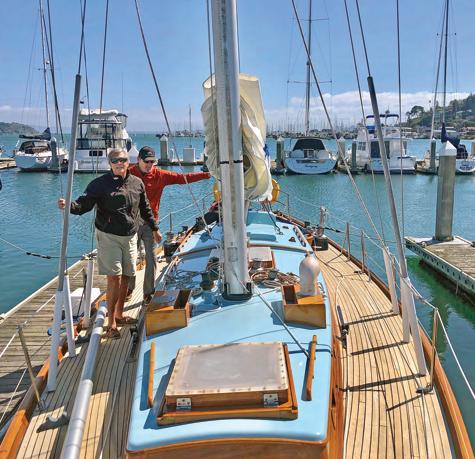
SIGHTINGS
band back together alpha — continued
During the Ha-Ha there will be the usual R&R stops at fun and funky Turtle Bay and pristine Bahia Santa Maria. Turtle Bay will be the site of the heralded 'Cruisers versus Turtle Bay Kids' ultra-fast-paced baseball game, where everybody gets a hit, and where women and children are always 'safe'. The next day is the potluck beach party at the edge of the badlands.
The stop at Bahia Santa Maria is ideal for beachcombing, surfing, paddling in the mangroves, and hill climbing. But the highlight is always the live-band rock 'n' roll party overlooking the anchored fleet. Dali never created anything as surreal.
Daily roll calls will include boat positions and professional weather reports from Commanders' Weather and other sources. has been part of StFYC for years, with a model of her on display in the front hallway.
When you jump onto a boat with a heritage like Alpha's, you have to do your best to capture her whole history. Nick discovered that the Haggin Museum in Stockton had all the files for Stephens Marine, so he called them up and was able to pick up a full file on Alpha, including more than 70 photos of her under construction. They show her solid, 1/4-inch welded aluminum plating and solid plywood bulkheads. At 33,000 lbs and solidly crafted, she is robust and easily manages anything the Bay throws at her.
While she's been well cared for over the course of her life, the frequently sailed 55-year-old vessel always appreciates attention. Nick has given her plenty. "Fixing her up has been a labor of love," he says. "I had Andy Richardson, the painter out of San Rafael Yacht Harbor, strip her down to the barrier coat. He then did a fabulous job repainting her." You'll see her as one of the very few baby-blue boats on the Bay. "Next came a full replacement of the teak toe rail by master wood craftsman Tony Ferrari. I then moved the jib tracks inboard from the rail and added new sails, going from a big 130% to a 90%. Now she points much closer to the wind and is much easier to tack. My God, she can point a hell of a lot better now!" Nick has owned Alpha for about five years. In fact, that's sort of how long he's been sailing. It's the first boat he's owned. That's a big start, so we asked how he started sailing and then came to buy Alpha. Nick says, "I first went to school on Catalina Island, while living there. We all learned to sail on FJs. But that was back in the '60s. Since then I'd only sailed occasionally with friends. But my grandfather, Arthur Rousseau, was a member of the St. Francis and a great sailor. He was well known for winning a lot of races, and that history kept me interested in getting back into sailing. And since my knees are kind of shot from 45 years of tennis and squash, I figured, well, I'm just gonna buy a sailboat." When Nick ran into his friend Rick Pfaff at StFYC, Pfaff happened to mention he was getting ready to sell Alpha. For Nick, the timing was just right. He said, "Hey, every once in a while you've got to be impulsive." He was captivated by the stunning, classic lines and says, "I just like old things." Amazingly, with the help of Rick and his regular crew, Nick has moved from FJs to Alpha after a 45-year break. It's been a long time since his dinghy sailing days at Catalina, but the basic instincts are there. Then it's a matter of getting used to the scale and motion of a stoutly built aluminum racer/cruiser. It's come somewhat naturally, but he also acknowledges it'll be a lifetime of learning. Between learning to sail, taking out a steady parade of friends, and ongoing projects and upgrades, Nick has made the boat a full-time obsession. Beyond previously mentioned improvements, Nick has added a new propane stove, new stainless steel muffler, new three-blade Martec prop, and new zinc anodes to prevent electrolysis, and refurbished the interior woodwork. It makes you wonder if you want to get her wet. Luckily Alpha is still solid as a rock and, like Nick, loves to sail the Bay. What's next? Nick had done a bit of racing on a friend's Bird Boat and has some interest in taking Alpha back onto the racecourse. Pfaff took her on the Transpac years ago, and she was a frequent racer in years past. Still, she's a lot of boat, so it may take some more time before he's comfortable to start racing. In the meantime, Nick and his crew get her out well over 20 times a year and have made a couple of Delta cruises to Tinsley Island. He's also looking forward to a trip down the coast to Monterey at some point, but for now, this locally built Sparkman & Stephens Bay classic is enjoying the new attention and frequent sails around the Bay. Keep an eye out for her on the Bay. She's a head-turner.
continued in middle column of next sightings page
— john

SIGHTINGS
knud wibroe — passing along a classic


ROSS TIBBITS Classics, be they works of art, automobiles or sailboats, are sold to the highest bidder at auction houses. Less often do we hear about individuals bestowing such items on a person who will continue to embrace the history, culture and preservation of the valued possession. One of the San Francisco sailing community's most legendary members is Knud Wibroe. Knud, a Dane, landed in San Francisco in 1953 at age 29. Best known for many things sailing, he is arguably one of the most storied racers on the Bay. Founder of the local Folkboat fl eet, admiral of the Knarr fl eet, and creator of the International Knarr Championship, he's pretty good at fi nding his way around a racecourse. In many ways, he's classic in his own right. At the spry age of 90, Knud retired from sailing in 2017. And instead of selling his beloved yacht, Snaps III, he gave it to longtime crewmember Mike Ratiani. Today, a little bit older and not quite as agile, Knud is still sharp as a tack and shows his age well. Sitting in his home among Knud Wibroe framed pictures of beautiful yachts, you can tell that sailing runs deep in his veins — he's been sailing his entire life. Asked how he met Mike, Knud recalls, "I was looking for some younger crew. He came on board, and I've sailed with him for 20 years. "He's a very, very good tactician, so that is nice," says Knud understatedly about Mike. Referring to their time racing the Knarrs in St. Francis Yacht Club's Wednesday Night Series (also founded by Knud), "Mike got more and more competitive. At fi rst it was easy; we did very well. But then the Perkins [brothers] joined the fl eet, and some Olympic sailors too. It became much more competitive! I still won races on Wednesday nights, but that was tough, real tough." By all indications, Knud had amassed an ideal crew. For Mike, that became the basis for his long-term friendship with Knud. When it came time to fi gure out Snaps III's future, a few things came quickly to mind. First off was that Snaps had become a member of the Wibroe family. Knud had not only spent years and countless hours racing her, but he'd also maintained her to a degree envied by any woodenboat owner — she'd been rebuilt twice by retired Danish boatbuilder Sean Hansen and fellow Dane Fred Andersen during his ownership — a rate at which Snaps could literally live forever. "A boat like Snaps, it was a very, very important part of my life. And I feel it is not really a classic in a real classic sense, but for me it is becoming a classic. Classic things like castles, you don't really own them, you are a custodian. You pass it on to a new generation so that they can enjoy it like you enjoyed it. And you fi nd somebody that you think can replace you; it's important. So, I decided to treat it like that, to keep the boat in good hands." It was also important to fi nd someone who believed, as did Knud, that the word Knarr meant more than just a class of boat. It is more entrenched than that. Knarr is family. And Mike understands. "I have enjoyed sailing on Snaps III a little less than half of her life," says



baja ha-ha
While at sea, those with SSB radios will be able to participate in the daily net. Those with just VHFs will be able to participate on the days the fl eet is in port. The radio net is one of the most popular features of the Ha-Ha. Informative, too, as there is always a wealth of knowledge in the fl eet. You can also count on the infamous HaHa dance party and popcorn throw at Squid Roe on the night of November 11, a beach party on November 12 with the popular
From peaceful sunsets at sea to the camaraderie of beach parties (like the one pictured below at undeveloped Bahia Santa Maria in normal '19), the Baja Ha-Ha offers something for everyone.
JENNIFER FROST
RICHARD SPINDLER
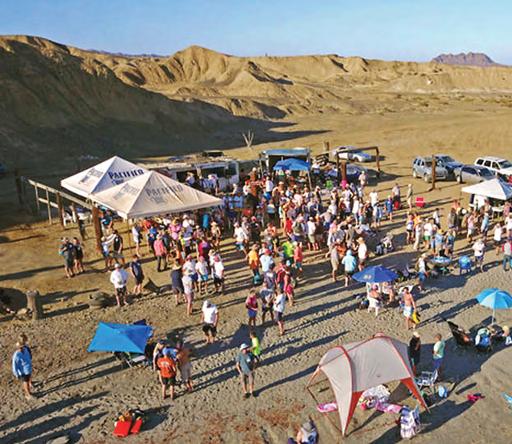
SIGHTINGS
— continued passing along a classic — continued
From Here to Eternity Kissing Contest in the surf, and an 'every boat gets an award' closing ceremony on Saturday the 13th. The Ha-Ha may take up just two weeks on the calendar, but you'll feel as though you've been adventuring for a month or more. Ha-Ha XXVII will be managed by the Grand Poobah, who has been in charge of all 26 Ha-Ha's to date, and who has sailed in all but the second one. Patsy 'La Reina del
continued in middle column of next sightings page Mike. "A Knarr is a living vessel containing both the beauty of the boat and the joy one can have sailing with friends. Snaps III has been in the care of Knud Wibroe for the last 56 years. I am honored to be a part of her life, and as such her next steward. We, the team of Bradford Whitaker, Bill Fredericks and I, have been sailing together for the last 10 and 17 years, respectively, with Knud. The three of us are quite honored to be able to carry on the traditions and love of our pride and joy, Snaps III, Knarr USA 120." Knud fi nishes his thought. "I'm very grateful to Mike for my success, so I think I should give it to him. I'm happy with that; everybody's happy." — ross tibbits
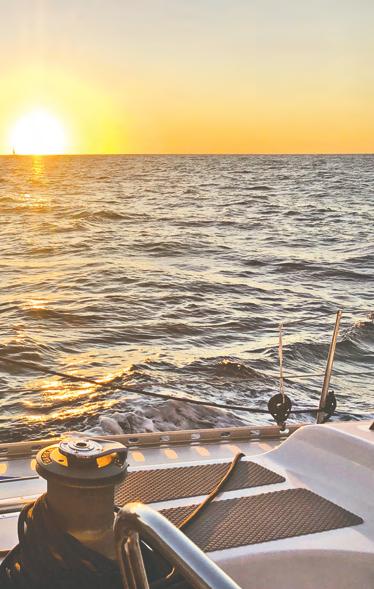



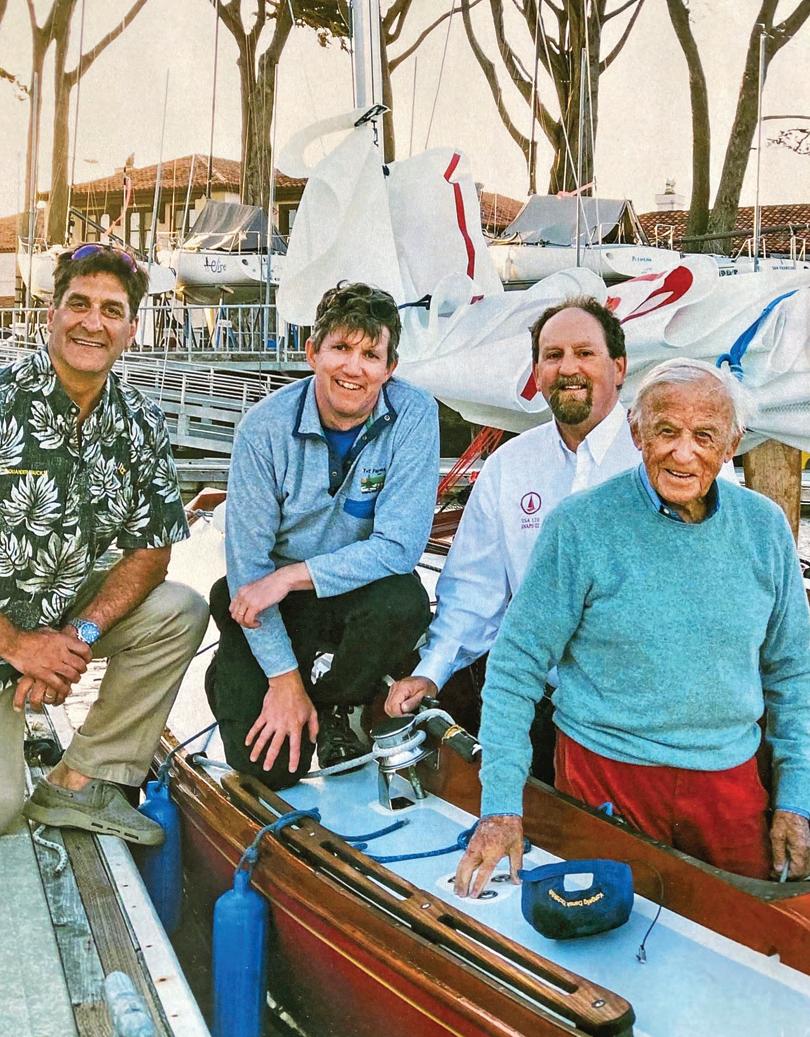

At the StFYC dock, left to right: Mike Ratiani, Bill Fredericks, Bradford Whitaker and Knud Wibroe. "The three of us are the new stewards of our beautiful Knarr 'Snaps III'," says Mike.
ROSS TIBBITS
SIGHTINGS
you're gonna need a bigger belt
As battery technology improves, battery banks can be charged faster. Lithium iron phosphate batteries (LiFePO4) can be completely recharged from nearly zero to full in about one hour, while lead-acid batteries take several hours just to replace half of their capacity. (With lead-acid batteries we follow the 50% rule, discharging to only half of the battery's capacity to extend its life.) Rapid charging is not just a matter of speed and convenience. Running your engine under low load, just to charge batteries, is bad for diesel engines. Diesels like to be run hot and hard, or else carbon deposits can foul the engine's innards. If we increase the amperage output to charge batteries faster, we're running the engine under more load for a shorter time, which keeps the engine happy. We increase the amperage by installing a higher-output alternator. Most engines come standard with relatively modest, automotive-style alternators, with internal regulators. (The regulator is the device that controls the alternator's output.) A common upgrade is to up-size the alternator and add an external digital regulator, which is well within the abilities of a doit-yourselfer. If you've got lead-acid batteries, a 100-amp alternator will likely be all you need on a standard cruising boat. Lead-acid batteries can only accept a bulk charge rate of 25-35% of their capacity per hour, so a 100-amp alternator is usually ample. If you've got lithium banks, then you'll want a charging capacity about equal to your battery capacity, because the batteries can accept a bulk charge of about 100% of capacity per hour. I.e., if you've got 200 amp hours of capacity, you'd want a 200-amp alternator, 300 for 300, etc. Unfortunately, we run into a wall with the drive belt. Most engines, especially older ones, come standard with a half-inch V-belt. There are several variables at play, including belt tension, amount of wear, and amount of wrap around the alternator pulley, but half-inch V-belts usually top out at around 100-120 amps (on a 12-volt system) before they overload and start to slip and squeal. To spin an alternator over 120 amps, we must upgrade to a serpentine belt. Serpentine belts are standard on all modern cars and some marine engines. With a single serpentine belt we can drive an alternator in the 300-amp range, after which we've attained charging nirvana with lithium banks: faster, more load on the engine, with full recharge in about an hour. (Note: Serpentine belts have various numbers of ribs. We need a six- or eight-rib to get where we're going, with six-rib being the most common.) Upgrading to a serpentine belt can get complicated, because it means replacing all three pulleys on the engine: one on the crankshaft, one for the water pump, and one for the alternator. The ideal serpentine system has a tensioner: a fourth, spring-loaded pulley that maintains perfect tension on the belt at all times. All cars have tensioners, but with many retrofi ts on marine engines there just isn't enough room, so we have to adjust the tension the old-fashioned way, by swinging the alternator. If you have a common engine, you'll be able to get an off-the-shelf serpentine-belt upgrade kit. If you can't fi nd an upgrade kit, it can be a slog. There are several ways that pulleys attach to shafts; some require special pullers to get them off, and it might be a machine-shop job to make the right pulleys to fi t your engine. Pulleys must be perfectly aligned, which you can check with a straightedge, but this might mean some washers or shims here and there, or even a special alternator bracket to get it right. You need the right ratios among your pulleys, which is straightforward You need the right ratios among your pulleys, which is straightforward math and sizing. The alternator will come with a spec sheet, showing its math and sizing. The alternator will come with a spec sheet, showing its outputs at various rpms, and you'll need to size the diameters of your outputs at various rpms, and you'll need to size the diameters of your pulleys so both the engine and the alternator turn at optimum speed for pulleys so both the engine and the alternator turn at optimum speed for charging. Finally, serpentine belts last longer, retain their tension better, and Finally, serpentine belts last longer, retain their tension better, and don't seem to slough off as much black dust, so engine compartments stay don't seem to slough off as much black dust, so engine compartments stay cleaner. They're just better.
— clark beek
baja ha-ha
Mar' Verhoeven, Assistant Poobah aboard her much-traveled Gulfstar 50 Talion, who put together last year's COVID-inspired Nada Ha-Ha, will be Head of Communications for the 14th year in a row. Head of Security Doña de Mallorca will be ready to crack heads for the 24th time. Fortunately, she's never had to raise her billy club in anger. Profl igate, the Poobah's Hughes 63 catamaran, will be the mothership for the 25th time. Her crew will cumulatively have sailed the Baja Coast well over 100 times. More than 10,000 sailors aboard more than 3,000 boats have done the Ha-Ha in the fi rst 26 years, and a number of them have counted the Ha-Ha among the highlights of their sailing careers — if not their lives. The Ha-Ha is a special experience that goes far beyond just sailing. Over the years it's generated countless lifetime friendships and several marriages — the latter for which the Ha-Ha cannot be held responsi-
BALMAR

— continued
ble. It's also been the first step in hundreds of South Pacific cruises and numerous circumnavigations.
Safety is the number-one goal of the HaHa, and so far the safety record has been excellent. In well over 2,250,000 cumulative Ha-Ha ocean miles, one boat was sunk by a whale (the entire crew was rescued); one boat was dismasted; and one boat was inexplicably driven ashore in calm weather and broken up with no injuries to the crew. And while there is a certain amount of additional safety in numbers, the Poobah emphasizes that the Ha-Ha is not an offshore babysitting service. Boat owners and crew are responsible for their own proper preparation and well-being. Looking for a wild and crazy alcohol-fueled reckless adventure? The Ha-Ha is not for you. It's for those interested in responsible fun.
The Ha-Ha is open to boats 27-ft or longer that were designed, built, and have "You're luffing," said Darrell.
I looked over from the horizon toward the forestay and saw the jib flap a bit before it settled into a crisp, flattened curve.
My reply revealed my ignorance: "No, I'm not… Wait, what do you mean?"
At 25 years old, I was a relative latecomer to sailing. It was my third or fourth lesson with Darrell Allen Caraway, my impromptu sailing instructor. I had approached him on Berkeley Marina's J Dock after seeing him sail into and out of his slip effortlessly on multiple occasions. My recently acquired Columbia 24 had maybe been out once in the two months since I had arrived. That was still more often than most of my neighbors. It seemed as if Darrell was the only actual sailor around, and certainly the only competent one. "You're luffing again. You're luffing. You're luffing!" he shouted, as I nosed up even farther into the wind before finally falling off and back to a close reach. I didn't mind getting berated from time to time. This sailing education came cheap. Sometimes we took my boat out and I paid Darrell in food or beer. Other times we took his boat, a Cal 20 rigged for easy singlehanding, and fittingly named Cheap Therapy.
It was in those four-hour sails just outside Berkeley that I gradually earned my sea legs. Once in a while I kicked Darrell $50 for his trouble, but I sensed that he didn't do it for the money so much as to share a craft
continued in middle column of next sightings page
SIGHTINGS
when the student is ready
BALMAR continued on outside column of next sightings page

Left to right: Checking the alignment of the serpentine pulleys with a laser guide; final installation of serpentine belt system, new Balmar alternator, and alternator swing arm; the serpentine belt and tensioner on the author's Subaru.

CLARK BEEK
SIGHTINGS
the student — continued
with a budding skipper who barely knew a beam reach from a broad. It may have helped that I greased his palm a bit, but my salty instructor friend seemed to get almost as much out of our joint sailing therapy sessions as I did.
As I learned the ropes — er, lines — Darrell lectured me with life lessons, and frequently ranted about his latest grievance. Among other monologues, I received a brief history of his architectural accomplishments around town. "Of course, nowadays it's all computerized," he lamented.
As the architecture industry had changed, Darrell had refused to change with it — opting instead to hone his hobbies of painting, sailing, and restoring classic cars into a full-time lifestyle occupation. Between gallery exhibitions in North Beach, he would set up his easel in front of East Bay shops, selling the paintings to the stores' owners. There's a rumor that the owner of Kingfish owns half a dozen of Darrell's depictions of Temescal's iconic Jamaican-themed pub. This little racket pays the bills for Darrell's two slips in Berkeley and Emery Cove, where he keeps a handsome Herreshoff 28 for longer sails and overnights. In his sailing style, as in his architectural leanings, Darrell retained the same old-school sensibilities, eschewing outboard motors and navigation apps. Even the weather forecast was suspect. His sail inventory, however, was always kept up to date.
After I mastered the basics of sail theory, tacking and jibing, we shifted our attention to the art of docking. Darrell taught me to troubleshoot my less-than-trusty Honda 5-hp outboard. Run the fuel out, take it out of the water, check the spark, etc.
We often had to troubleshoot on the water, where I quickly learned what it feels like to flood the motor with too much gas, and how to fix it without needing to make an emergency landing.
Eventually, I gained the confidence to sail into and out of my slip with no motor. It was never tuned up well enough to rely on anyway, so I figured I might as well learn to get into and out of the marina on sail only. Darrell taught me to tack in tight quarters and use a spring line as 'brakes' when docking in my downwind slip.
Once I could do this alone, I started to go out more regularly. Darrell still came along every once in a while, but he was spending less time on the tiller and more time hanging back on the lifelines while I sailed my own boat. During one memorable sail, headed along the windy windward side of Treasure Island, the clevis ring popped out of the lifeline where it connected to the stern pulpit, and Darrell fell overboard — except for his legs — while I continued to steer the boat along a beam reach. Too flustered to think about cutting the main or altering course, I simply leaned over and grabbed my wet, salty friend by the arms and pulled him back into the boat. The water that had flooded his foul weather jacket made him twice as heavy. But we sailed onward. Humbled by the experience, Darrell didn't dare to criticize me for weaving or luffing the entire way home.
Fast-forward three years and I decided to get serious about my sailing career. Cobbling together our dozens of lessons with my own singlehanding time and a smattering of commercial sea service, I decided to apply for my captain's license. Before signing me off for the days on his boat, Darrell quizzed me with a diagram of a sailboat. The standard questions, as if from a basic keelboat exam, had been part of my vocabulary for years, but I wasn't considered a graduate of the Darrell Caraway Academy for Motorless Sailing Excellence until I completed this rite of passage.
Earlier this year, I re-enrolled, so to speak, in his impromptu sailing school to learn the subtle art of spinnaker flying. We had talked about it for years but never actually flown one on my boat. I kicked Darrell 100 bucks advance payment for a couple of future lessons.
Then the texts started coming in. Some days it was just one or two but other days I would get a flurry of a dozen texts or more reviewing the ins and outs of flying a spinnaker, as he pulled his years of racing experience out of the archive of long-term memory. The stream-of-consciousness descriptions seemed disjointed to me, since I lacked any real frame of
baja ha-ha — continued
CHARLIE DIEST
LATITUDE / JOHN been maintained for offshore sailing. There must be at least two crew with overnight offshore experience. All boats are required to have the capability for two-way communication. Garmin inReach and Iridium GO! will do just fine, although SSB radio makes the event even more fun.
Ha-Ha weather is typically 5-15 knots from astern, although naturally all participants must be prepared for potentially stronger weather.
Notice of the event, with more details, was posted on April 6 at www.baja-haha. com. The registration form, pay site, and waivers will all go live at noon on May 6.
We hope you'll join Ha-Ha XXVII and become a part of Baja sailing history. — richard spindler

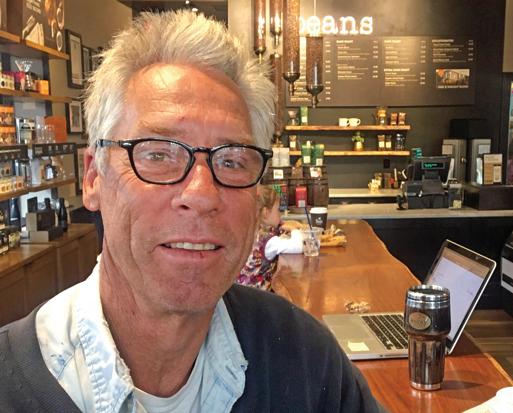
tossing out that epirb
With the shelter-in-place restrictions ending, the Coast Guard is seeing vessel traffi c increase throughout California's waterways. Maybe, during the months of hunkering down, you might have cleaned out your boat or garage, and now you want to dispose of some old equipment. Before tossing that old 406MHz Emergency Position Indicating Radio Beacon (EPIRB) or Personal Locator Beacon (PLB) into the trash, please take a moment to disconnect the battery. "In 2020, 26% of the 406MHz beacon alerts were tracked to a mariner who disposed of their beacon and it accidentally activated while in a landfi ll or garbage removal truck," said Douglas Samp, an 11th
continued in middle column of next sightings page




SIGHTINGS
the student — continued
reference for what he was talking about. However, after our fi rst real session in light winds, the terms and explanations started to click. I quickly learned the difference between the guy and the foreguy, but had to make frequent recourse to weeks-old text messages to remember what he had taught me. Sick of scrolling backward, I sat down to copy and paste every spinnaker-related text message from my phone into a single document. Anyone can sail — I'm proof. As the old proverb goes, "When the student is ready, the teacher will appear." Spend some time on the dock, ready to learn, and you will fi nd out how true this wisdom is.
— charlie diest
Readers — Darrell and Charlie made a book of Darrell's nautical paintings and text message instructions called Three Sheets to the Wind: The Art of Spinnaker. The book will be available on Amazon as a hardcover. To celebrate, they took a trip out the Golden Gate before heading back just in time to see the end of a midwinter race. Watch the video on Facebook at www.facebook.com/chdeist/posts/10217831209545588.
Clockwise from top left: Charlie Deist and Darrell Allen Caraway refi ning the art of sailing; Charlie and Darrell aboard the H-28 'Nandi'; Darrell holds court at Peet's on 4th Street in Berkeley.
NANDI
SIGHTINGS
paul cayard takes on new role
Los Angeles will host the Summer Olympics in 2028. For Paul Cayard, US Sailing's new hire, that's a perfect goalpost for his role as executive director of US Olympic Sailing, taking the helm of the US Sailing Team inclusive of the US Olympic Sailing program. "I feel like I can be successful at this job. As an American sailor, that would be very satisfying," Cayard explained. "It's in my wheelhouse — the industry that has been my career — and it's a challenge that inspires me and has captivated me. The job has been hard to do; there have been various efforts at doing it in the last 10-12 years, and we haven't quite got there. I know we can be successful." Cayard noted that the US has been at the top of the sailing world, winning three golds and four silvers in seven events in the 1984 Olympics in Los Angeles. He believes America can be competitive again. "The mission is really much broader than just the Olympics, however. We need to reinvigorate American sailing. The Olympics is the lightning rod for that." His new role, as he sees it, is to bring America's absolute best resources to bear on the US Olympic Sailing program. The desired outcomes of this strategy? To dominate the Olympic podium and create a deep bench of world-class sailors who, in turn, lead the country's high-profi le teams and inspire a nation. "My job is to build the machine that's in the middle between the pillars of excellence and the fi eld of play," Cayard explained. "In America we have access to the excellence, but we haven't succeeded in bringing it to bear on the fi eld of play. It involves understanding where we want to be and where this excellence is in America, and hiring the right people with the right skill set." Fundraising will be a signifi cant part of Cayard's role, as the fi nancial element will be key to achieving the result that Cayard wants. "In the US we still operate in the 'bring your own' model," he said. "The team that's in place is doing a pretty good job with $4 million a year, but there's just not a lot you can do with that. I need to be that passionate, inspirational person to make a credible pitch to get the additional backing we need." A critical element in the pipeline that lives alongside funding is talent. Cayard envisages that the machine will, year in and year out, produce a pipeline of fi ve to six teams deep in world-class talent in the 10 Olympic classes, so 40 or 50 teams of athletes who are not only truly skilled in

continued on outside column of next sightings page


National Sailing Hall of Fame awards ceremony, San Diego YC, October 2011. Three generations of Cayards — Pierre, Paul and Danny — pose with Paul's boyhood El Toro, lovingly restored earlier that year by Pierre.

LATITUDE / JOHN

epirb — continued
Coast Guard District search and rescue specialist. "We have seen beacons manufactured in the 1990s activate while in a landfi ll where the COSPAS-SARSAT satellites can still acquire the distress signal." Responding to false alerts can cause large delays for Coast Guard rescue personnel response to real emergencies, and puts their lives at risk unnecessarily. So, at the end of the useful life of your 406MHz beacon, please dispose of it properly. When doing so, it is vital that you follow the manufacturer's guidance on how to disable your beacon to eliminate false activations. Most manufacturers recommend that you remove the beacon's battery when disposing of it to prevent false activations. Before you throw it out, please update your registration at the NOAA Beacon Registration website to indicate this change in status. If you lack internet access or would prefer to mail, fax or email your registration updates, please contact the SARSAT Beacon Registration Database Team for assistance. See https://beaconregistration.noaa.gov; phone (888) 212-7283 (toll-free) or (301) 817-4515; fax (301) 817-4565; or email beacon.registration@noaa.gov. Once your beacon has been permanently disabled, the remaining parts (including the battery and electronics) should be disposed of in a manner that does not present a threat to the environment. In addition to containing traces of lithium, distress beacons may contain lead and brominated fl ame retardants in the housing material and circuit boards. Please do not simply discard the beacon along with residential garbage or in a community landfi ll. Review your local laws and procedures for disposal of electronics and batteries, or contact your beacon manufacturer for further guidance. "The 406MHz beacon is an incredible piece of technology, and in a distress situation, I would want a 406MHz EPIRB with me to signal for help," said Samp. "With proper care, maintenance and battery replacement, your 406MHz beacon (EPIRB or PLB) will be a reliable distress device for many years." To celebrate the COSPAS-SARSAT system, post your favorite beacon picture with the hashtag #406day.
— john



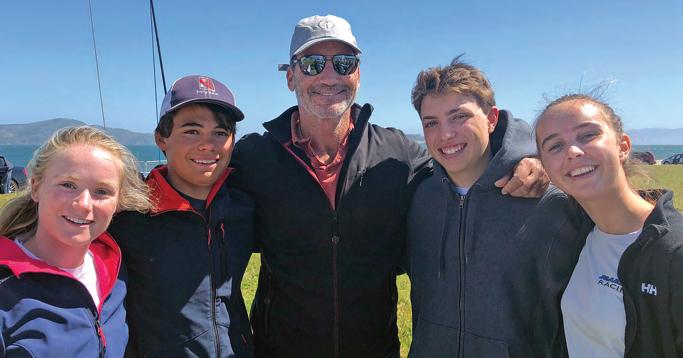
delta doo dah kicks off
Delta Doo Dah Lucky 13 has been accepting free online entries since St. Patrick's Day, but the rally will kick off for real (but virtually) on Tuesday, May 4. That's when we'll host (via Zoom) our Kickoff event (it will be up to each of you in your respective homes or boats to make it a 'party'). The centerpiece and bulk of the evening will be Craig and Ann Perez's Delta Cruising Seminar. Members of Richmond YC (Craig was commodore in 2015), the Perezes have been cruising the Delta for 20 years with their Express 34 Marrakesh. Among the topics covered will be: Planning Your Departure, Length of Cruise, Stopovers and Anchorages, Infl atables and Small Engines, Shade, Ladders, Cooking, Refrigeration, Batteries, Waste Water and Storage, Pets, Sleeping, Water Toys and Itineraries. This seminar will be especially useful to fi rst-timers, but we encourage everyone to participate. We always pick up new tips and ideas, and cruisers with experience will be invited to share morsels of knowledge with the fl eet. There'll be time for questions too.

We'll also talk more about this year's plans in particular, with VIP guests. And, what would a Delta Doo Dah Kickoff be without door prizes? You must 'attend' the Kickoff for a chance to win a prize. The offi cial event will take place from 6 to 9 p.m., but we'll begin checking in Doo Dah'ers as early as 5:30. If you check in before we get into the agenda, we'll invite you to introduce yourself and say a bit about your boat and your plans. But join in whenever you can — we realize that there are people out there who actually have to drive home from a workplace in order to begin their evenings! To be invited to the Kickoff and receive your Zoom link, fi rst sign up for the Delta Doo Dah at www.deltadoodah.com, where you'll also fi nd more details about the rally. As of April 26, 65 boats had entered. — chris
SIGHTINGS
paul cayard — continued
sailing but know how to be dedicated, committed, focused, disciplined — all the personal skills that it takes to be a great athlete. In 2014, Cayard and the late Bob Billingham envisioned a critical piece of the puzzle: a pipeline of talent. Project Pipeline, which was founded with the support of America One, Cayard's 2000 America's Cup campaign, put up $5 million to train America's most promising 15- to 19-year-olds. In 2017, 2018 and 2019, the US was the lead nation at the Youth World Championship over that period, taking a third, a fi rst and a third. "Creating the talent pipeline isn't like a switch that gets fl ipped on and suddenly a bunch of talent appears," Cayard reminded. "Fortunately, Project Pipeline is beginning to bear fruit — in a few months, the oldest alumnus of that group, Riley Gibbs (24), will be going to his fi rst Olympics in the Nacra 17. He'll probably be in his prime in France in 2024, and defi nitely ready to take gold in 2028 in Los Angeles." He expects the US Open Series, a new circuit of six Olympic Class regattas developed with West Marine and slated to be held annually, will help develop depth in the pipeline. The series consists of three regattas in Florida over the winter, and three summer regattas in San Diego, Long Beach and San Francisco. Additionally, the heavy-weather Olympic Development Program will continue to be held in San Francisco. "San Francisco is still a fantastic training area for any high-level sailing athlete," Cayard says with a smile. Cayard also wants to bring the Olympic Trials back to the US. "That was such a formative event," he said. "I went to the Olympic Trials in '84 because it was in Long Beach and I could. We didn't have any money to go to Olympic Trials elsewhere — we just wouldn't have gone, and John Kostecki wouldn't have gone either." Cayard maintains that mentoring is also a big part of athlete support. He's grateful to those who helped establish his skills and career. He feels fortunate that Tom Blackaller latched onto him all those years ago, asking Cayard to sail with him fi rst in the Star, then in the America's Cup. "During the time I was with him, from age 18 to 28, Tom taught me the fi ner points of racing, strategy and tactics — he was a huge mentor for me. Raul Gardini (chairman of the syndicate that sponsored the Italian America's Cup contestant Il Moro di Venezia) was also an important mentor for me, less in sailing but more in organization, leadership, delegation and how to run a bigger operation. "To win we need to garner all forms of support, fi nancial, mentoring, and to focus on organization, technology, elite coaching, high-performance athleticism, and our athlete pipeline," Cayard concluded. "The US is the top nation in all these critical categories. What we haven't done is bring that excellence to bear on the fi eld of play through our talented athletes. But that is what we will do by 2028 in Los Angeles. Tokyo and Paris are great intermediate milestones for us to measure our progress." — michelle slade
Nacra 15 sailors Cali Salinas, Hoel Menard, Jack Sutter and Charlotte Versavel with Paul Cayard.
PAM HEALY







